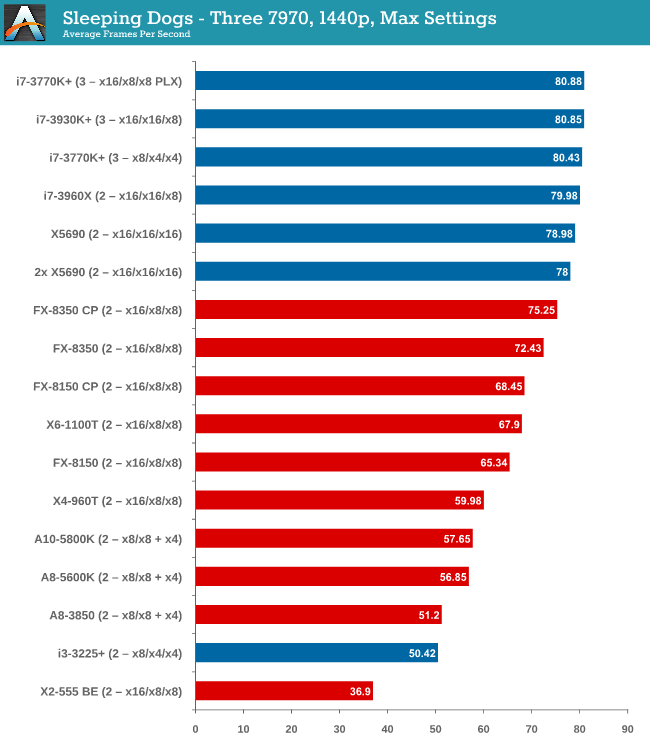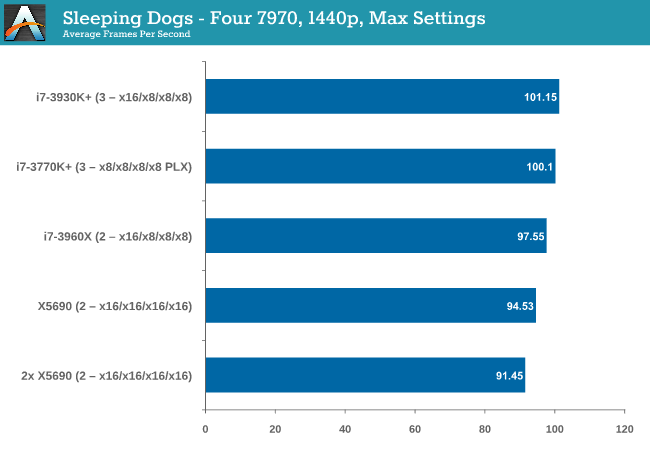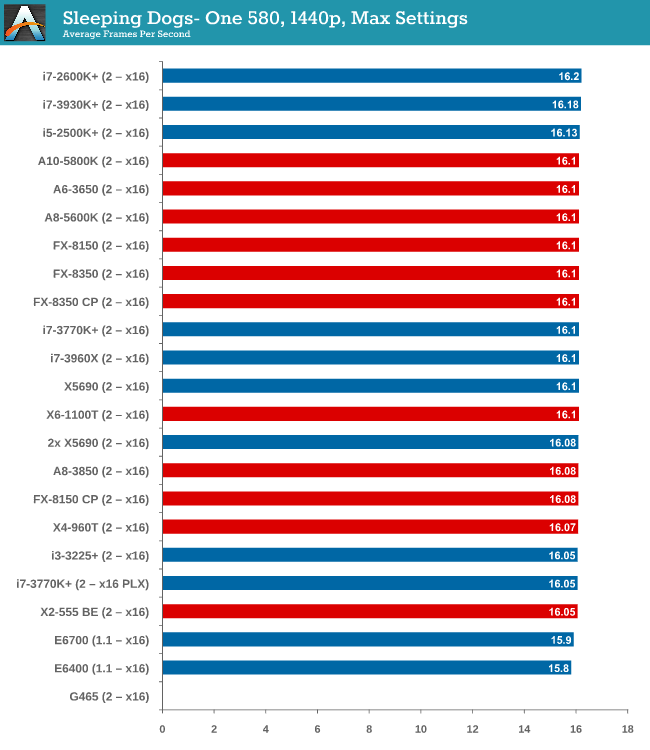Choosing a Gaming CPU: Single + Multi-GPU at 1440p, April 2013
by Ian Cutress on May 8, 2013 10:00 AM ESTSleeping Dogs
While not necessarily a game on everybody’s lips, Sleeping Dogs is a strenuous game with a pretty hardcore benchmark that scales well with additional GPU power. The team over at Adrenaline.com.br are supreme for making an easy to use benchmark GUI, allowing a numpty like me to charge ahead with a set of four 1440p runs with maximum graphical settings.
One 7970

Sleeping Dogs seems to tax the CPU so little that the only CPU that falls behind by the smallest of margins is an E6400 (and the G465 which would not run the benchmark). Intel visually takes all the top spots, but AMD is all in the mix with less than 0.5 FPS splitting an X2-555 BE and an i7-3770K.
Two 7970s

A split starts to develop between Intel and AMD again, although you would be hard pressed to choose between the CPUs as everything above an i3-3225 scores 50-56 FPS. The X2-555 BE unfortunately drops off, suggesting that Sleeping Dogs is a fan of the cores and this little CPU is a lacking.
Three 7970s

At three GPUs the gap is there, with the best Intel processors over 10% ahead of the best AMD. Neither PCIe lane allocation or memory seems to be playing a part, just a case of threads then single thread performance.
Four 7970s

Despite our Beast machine having double the threads, an i7-3960X in PCIe 3.0 mode takes top spot.
It is worth noting the scaling in Sleeping Dogs. The i7-3960X moved from 28.2 -> 56.23 -> 80.85 -> 101.15 FPS, achieving +71% increase of a single card moving from 3 to 4. This speaks of a well written game more than anything.
One 580

There is almost nothing to separate every CPU when using a single GTX 580.
Two 580s

Same thing with two GTX 580s – even an X2-555 BE is within 1 FPS (3%) of an i7-3960X.
Sleeping Dogs Conclusion
Due to the successful scaling and GPU limited nature of Sleeping Dogs, almost any CPU you throw at it will get the same result. When you move into three GPUs or more territory, it seems that having the single thread CPU speed of an Intel processor gets a few more FPS at the end of the day.










242 Comments
View All Comments
Pheesh - Wednesday, May 8, 2013 - link
"2) Min FPS falls under the issue of statistical reporting. If you run a game benchmark (Dirt3) and in one scene of genuine gameplay there is a 6-car pileup, it would show the min FPS of that one scene. So if that happened on an FX-8350 and min-FPS was down to 20 FPS when others didn't have this scene were around 90 FPS for minimum, how is that easily reported and conveyed in a reasonable way to the public? A certain amount of acknowledgement is made on the fact that we're taking overall average numbers, and that users would apply brain matter with regard to an 'average minimum'."The point of a benchmark is to provide a consistent test that can be replicated exactly on multiple systems. If you're not able to do that then you aren't really benchmarking anything. That's why 99% of games are not tested in multiplayer but rather single player in experiences they can strictly control. (i.e. with test demos). If for some reason the game engine is just that unpredictable even in a strictly controlled test situation you could do multiple trials to take a minimum average.
Minimum FPS is an extremely necessary test and its easily possible to do. Other sites include it with all of their gaming benchmarks.
Spunjji - Wednesday, May 8, 2013 - link
That doesn't necessarily mean that the numbers they give you are worth a damn...beginner99 - Thursday, May 9, 2013 - link
"Minimum FPS is an extremely necessary test and its easily possible to do. Other sites include it with all of their gaming benchmarks."Or you could do 5 runs, discard the worst and best and average the rest (min, max average FPS).
http://en.wikipedia.org/wiki/Truncated_mean
But yeah statistics is extremely complex and error prone. I once read that a large amount of statistics in scientific publications have errors to a certain degree (but not necessarily making the results and conclusions completely wrong!!!)
Or if you actually know such a "special scene" can happen, discard all test were it happened.
beginner99 - Thursday, May 9, 2013 - link
The main issue here is actually available time or the amount of work. Averages over 3 aren't really that great. if you could run everything 100 times such "special scenes" would be irrelevant.mapesdhs - Monday, May 20, 2013 - link
Ian,
P55 boards can offer very good RAID0 performance with SSDs, or more importantly
RAID1 or RAID10 (I hope those with RAID0 have some kind of sensible backup
strategy). See my results:
http://www.sgidepot.co.uk/misc/ssd_tests.txt
One will obviously get more out of newer SSDs using native SATA3 mbds for the
sequential tests, but newer tech won't help 4K numbers that much. In reality few
would notice the difference between each type of setup. This is especially true
given how many later mbds use the really awful Marvell controllers for most of the
SATA3 ports (such a shame only a couple are normally controlled by the Intel or
other chipset); performance would be better with an older Intel SATA2. I expect
many just use the non-Marvell ports only if they can.
What matters is to have an SSD setup of some kind in the 1st place. My P55 system
(875K) boots very quick with a Vertex3, gives a higher 3DMark13 physics score than
a 3570K, and GPU performance with two 2x 560Ti is better than a stock 680. It's
really the previous gen of hw which can present more serious bottlenecks (S775,
AM2, DDR2, etc.), but even then results can often be surprisingly decent, eg. oc'd
Ph2 965, etc.
Also, RAID0 with SSDs often negates the potential of small I/O performance.
Depending on the game/task, this means SSD RAID0 might at times be slower than a
single good SSD.
Dribble is right in that respect, improvements are often not as significant as
people think or expect (I've read sooo many posts from those who have been
disappointed with their upgrades), though it does vary by game, settings, etc.
Games which impose a heavier CPU loading (physics, multiplayer, AI etc.) might see
more useful speedups from a better CPU, but not always. There are so many factors
involved, it can become complicated very quickly.
Ian.
Felix_Ram - Sunday, May 26, 2013 - link
Your 120 hz screen has a frame latency of about 8 ms. Meaning it effectively can't show you more than 60 new fps. Anything above that it shows you the same pixel twice. So basically, you are watching reruns, and anyone who states that he can tell a difference between 60 fps and +60fps is basically kidding himself.http://forums.anandtech.com/showthread.php?t=23049...
http://forums.steamgames.com/forums/showthread.php...
Felix_Ram - Sunday, May 26, 2013 - link
Can't edit. A screen latency of about 16 ms*tehh4ck3r - Wednesday, May 8, 2013 - link
You should test a Phenom II X4-965 and a i5-3570K.B-Unit1701 - Wednesday, May 8, 2013 - link
And throw in a 45nm Core2, preferably over 3.0Ghzboulard83 - Wednesday, May 8, 2013 - link
Really great review and testing. As for the CPU to add to the list, you could add some very cheap solution like the G1610 and G2020 too see how these 40-60$ chip perform againts all other chip or simply compare to an older E6700 like the one on the test. Other than that, you could also add a 3820 in the testing simply to lower the cost of the X79 setup, making it a little more mainstream VS a 600$ 3930k.